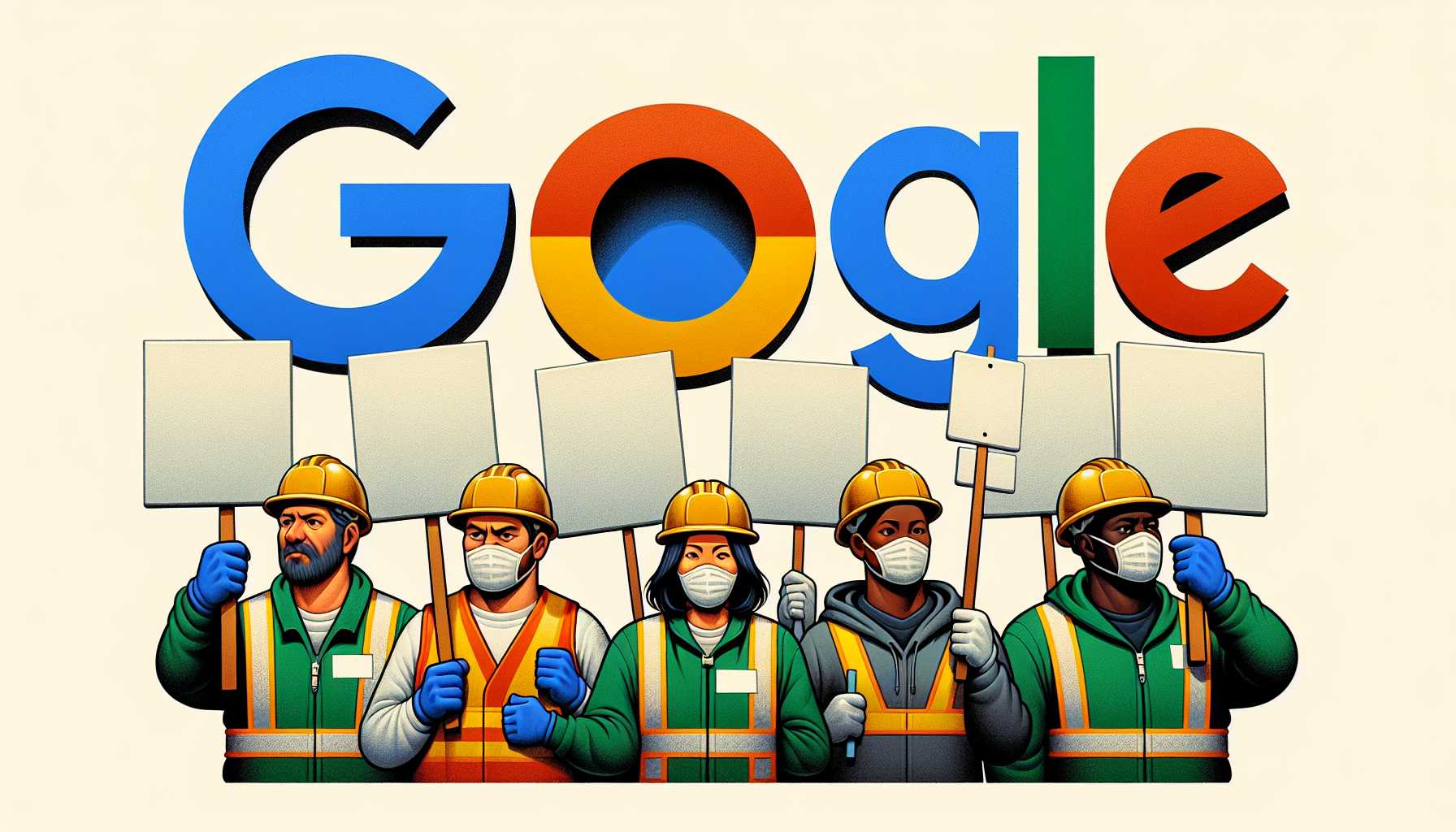Google’s Labor Dispute: A Turn of the Tables
 Technology giant Google finds itself in a tight spot yet again concerning labor relations. The National Labor Relations Board (NLRB) has ruled that Google’s refusal to bargain with a group of unionized YouTube Music contractors is unacceptable and illegal. This precedent, undeniably significant for workers across the tech industry, resonates with a David versus Goliath scenario where collective bargaining power managed to chip away at corporate resistance. As an industry insider, I’ve seen the back and forth of employers and labor unions. Typically, companies like Google keep employment terms ambiguous to maintain a certain distance from contractors, but according to the NLRB’s recent decision, Google and Cognizant are “joint employers” of these Austin-based workers. It’s a telling moment that reflects the labor market’s shifts as technology workers are increasingly aware of their collective bargaining rights and as digital corporations must adapt their human resource strategies accordingly.
Technology giant Google finds itself in a tight spot yet again concerning labor relations. The National Labor Relations Board (NLRB) has ruled that Google’s refusal to bargain with a group of unionized YouTube Music contractors is unacceptable and illegal. This precedent, undeniably significant for workers across the tech industry, resonates with a David versus Goliath scenario where collective bargaining power managed to chip away at corporate resistance. As an industry insider, I’ve seen the back and forth of employers and labor unions. Typically, companies like Google keep employment terms ambiguous to maintain a certain distance from contractors, but according to the NLRB’s recent decision, Google and Cognizant are “joint employers” of these Austin-based workers. It’s a telling moment that reflects the labor market’s shifts as technology workers are increasingly aware of their collective bargaining rights and as digital corporations must adapt their human resource strategies accordingly.
Cybersecurity’s Learning Curve: Ethical Hacking Demystified
 While giants like Google navigate the evolving labor landscape, other tech news shines a spotlight on cybersecurity education — a realm I’m particularly fascinated by. The tech industry’s hunger for secure digital spaces gives rise to opportunities like the All-in-One 2023 Super-Sized Ethical Hacking Bundle. Beyond the buzz and marketable appeal, these comprehensive courses underscore the industry’s critical need for skilled white-hat hackers. Diving into ethical hacking is not just about donning a virtual black hoodie and joining the ranks of digital vigilantes. It’s about understanding the delicate fabric of our digital existence — from server security to pinpointing algorithmic vulnerabilities. For tech enthusiasts seeking self-paced advancement or seasoned professionals aiming to solidify their defense arsenal, ethical hacking represents a galactic playfield where your skills can quite literally block or launch the next tech ‘big bang’.
While giants like Google navigate the evolving labor landscape, other tech news shines a spotlight on cybersecurity education — a realm I’m particularly fascinated by. The tech industry’s hunger for secure digital spaces gives rise to opportunities like the All-in-One 2023 Super-Sized Ethical Hacking Bundle. Beyond the buzz and marketable appeal, these comprehensive courses underscore the industry’s critical need for skilled white-hat hackers. Diving into ethical hacking is not just about donning a virtual black hoodie and joining the ranks of digital vigilantes. It’s about understanding the delicate fabric of our digital existence — from server security to pinpointing algorithmic vulnerabilities. For tech enthusiasts seeking self-paced advancement or seasoned professionals aiming to solidify their defense arsenal, ethical hacking represents a galactic playfield where your skills can quite literally block or launch the next tech ‘big bang’.
The VPN Paradox: A Cloak of Invisibility in a Peering Digital World
 VPNs, our digital invisibility cloaks, have garnered attention in the online privacy debate. As we navigate the treacherous waters of the internet, the spotlight glares on Virtual Private Networks (VPNs) — a technology that I consider an essential piece of the privacy puzzle. Your digital footprint, more vulnerable than you might think, requires protection from the constant threats of hackers and surveillance. A VPN stretches an encrypted tunnel over your data traffic; it is crucial not just for individuals valuing their privacy but for corporate entities shielding sensitive information from digital marauders. Moreover, the versatility of VPNs stretches beyond security — they are also potent tools to circumvent geo-restrictions, opening up a treasure trove of streaming content. But when considering a VPN service, don’t be swayed by the allure of free services. The golden rule in tech applies — if the product is free, you might very well be the product.
VPNs, our digital invisibility cloaks, have garnered attention in the online privacy debate. As we navigate the treacherous waters of the internet, the spotlight glares on Virtual Private Networks (VPNs) — a technology that I consider an essential piece of the privacy puzzle. Your digital footprint, more vulnerable than you might think, requires protection from the constant threats of hackers and surveillance. A VPN stretches an encrypted tunnel over your data traffic; it is crucial not just for individuals valuing their privacy but for corporate entities shielding sensitive information from digital marauders. Moreover, the versatility of VPNs stretches beyond security — they are also potent tools to circumvent geo-restrictions, opening up a treasure trove of streaming content. But when considering a VPN service, don’t be swayed by the allure of free services. The golden rule in tech applies — if the product is free, you might very well be the product.
Political Narratives & Tech Leadership: Voices from the Industry’s Halls
 In the backdrop of technical advancements and corporate rulings, it’s worth noting that tech leaders are not just influential in product development or industry trends, but also in political and social spheres. OpenAI’s Sam Altman’s recent comments highlight this dual role. Altman’s words extend a hand in solidarity with Muslim, Arab, and especially Palestinian colleagues in tech, who feel stifled in sharing their experiences amid the Israeli-Palestinian conflict. As a tech observer, these pronouncements from influential figures like Altman signify the tech industry’s multi-dimensional influence. These thought leaders don’t stay confined within the bounds of their technical domains; their perspectives echo in socio-political corridors, testifying to the sector’s pervasive impact.
In the backdrop of technical advancements and corporate rulings, it’s worth noting that tech leaders are not just influential in product development or industry trends, but also in political and social spheres. OpenAI’s Sam Altman’s recent comments highlight this dual role. Altman’s words extend a hand in solidarity with Muslim, Arab, and especially Palestinian colleagues in tech, who feel stifled in sharing their experiences amid the Israeli-Palestinian conflict. As a tech observer, these pronouncements from influential figures like Altman signify the tech industry’s multi-dimensional influence. These thought leaders don’t stay confined within the bounds of their technical domains; their perspectives echo in socio-political corridors, testifying to the sector’s pervasive impact.
The Beguiling Allure of AI Hallucinations
 Lastly, let’s muse over large language models (LLMs) and their penchant for so-called ‘hallucinations,’ a quaint term that glosses over the phenomenon of AIs weaving fact with fiction. Here, AI’s weakness also unveils its charm; erroneous though these fabrications may be, they challenge us to discern the boundless landscapes of machine-generated content. AI companies toil relentlessly to minimize these glitches. Yet, I find a certain allure to AI hallucinations; they reflect, inadvertently, our world’s complexity. Whether AI’s fictitious musings enrapture or enrage us, they necessitate a closer examination of the crossroads where human discernment meets machine-generated content. To illustrate, an AI-generated obituary of a living person might interlace truths with aspirational elements, echoes of a life that could have been under different stars. In this mirror held up by AI, we don’t see the harsh reflection of reality but rather, a whimsical image drawn from the vast canvas of probable existences. The quirks of AI-generated prose, like the caprices of life, keep us wondering and, often, bemusedly nodding at the surreal yet familiar tales that emerge. In closing, our tech landscape is an ever-evolving maze of rules, learning, and debates intermingled with the human consequence. From Google’s labor relations saga and the untapped frontiers of ethical hacking to the indispensable shield of VPNs and the stirring words of tech leaders, it is clear that the realm of technology is as diverse and complex as the human element it so profoundly touches.
Lastly, let’s muse over large language models (LLMs) and their penchant for so-called ‘hallucinations,’ a quaint term that glosses over the phenomenon of AIs weaving fact with fiction. Here, AI’s weakness also unveils its charm; erroneous though these fabrications may be, they challenge us to discern the boundless landscapes of machine-generated content. AI companies toil relentlessly to minimize these glitches. Yet, I find a certain allure to AI hallucinations; they reflect, inadvertently, our world’s complexity. Whether AI’s fictitious musings enrapture or enrage us, they necessitate a closer examination of the crossroads where human discernment meets machine-generated content. To illustrate, an AI-generated obituary of a living person might interlace truths with aspirational elements, echoes of a life that could have been under different stars. In this mirror held up by AI, we don’t see the harsh reflection of reality but rather, a whimsical image drawn from the vast canvas of probable existences. The quirks of AI-generated prose, like the caprices of life, keep us wondering and, often, bemusedly nodding at the surreal yet familiar tales that emerge. In closing, our tech landscape is an ever-evolving maze of rules, learning, and debates intermingled with the human consequence. From Google’s labor relations saga and the untapped frontiers of ethical hacking to the indispensable shield of VPNs and the stirring words of tech leaders, it is clear that the realm of technology is as diverse and complex as the human element it so profoundly touches.





